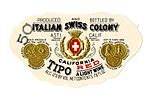Buena Vista Winery
1857 establishments in CaliforniaBuildings and structures in Sonoma, CaliforniaHistory of Sonoma County, CaliforniaIndustrial buildings and structures on the National Register of Historic Places in CaliforniaIndustrial buildings completed in 1857 ... and 4 more
National Register of Historic Places in Sonoma County, CaliforniaSonoma ValleyTourist attractions in Sonoma County, CaliforniaWineries in Sonoma County

Buena Vista Winery is a winery located in Sonoma, California, United States. It is the second oldest winery in California after the D'Agostini Winery, which was founded a year prior in 1856. It was founded by Agoston Haraszthy in 1857. The winery is located on its original grounds, just east of Sonoma, California.
Excerpt from the Wikipedia article Buena Vista Winery (License: CC BY-SA 3.0, Authors, Images).Buena Vista Winery
Old Winery Road,
Geographical coordinates (GPS) Address External links Nearby Places Show on map
Geographical coordinates (GPS)
| Latitude | Longitude |
|---|---|
| N 38.299444444444 ° | E -122.42305555556 ° |
Address
Buena Vista Winery
Old Winery Road
95476
California, United States
Open on Google Maps






